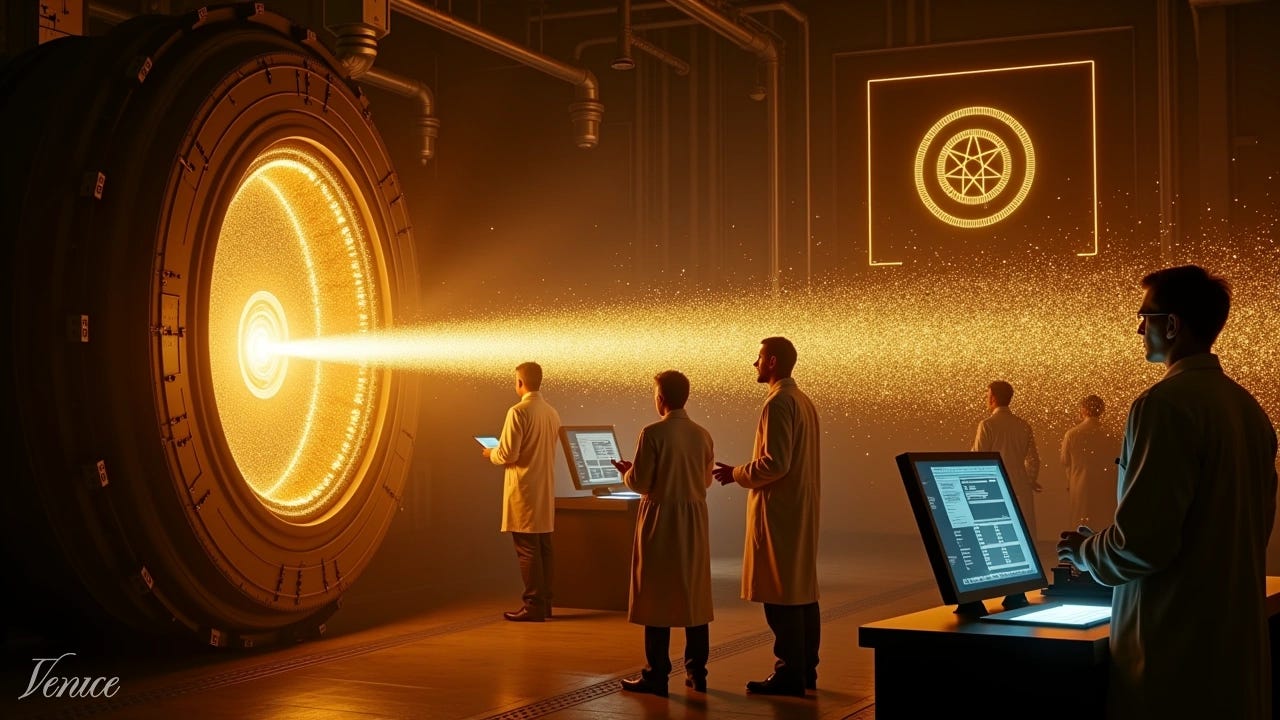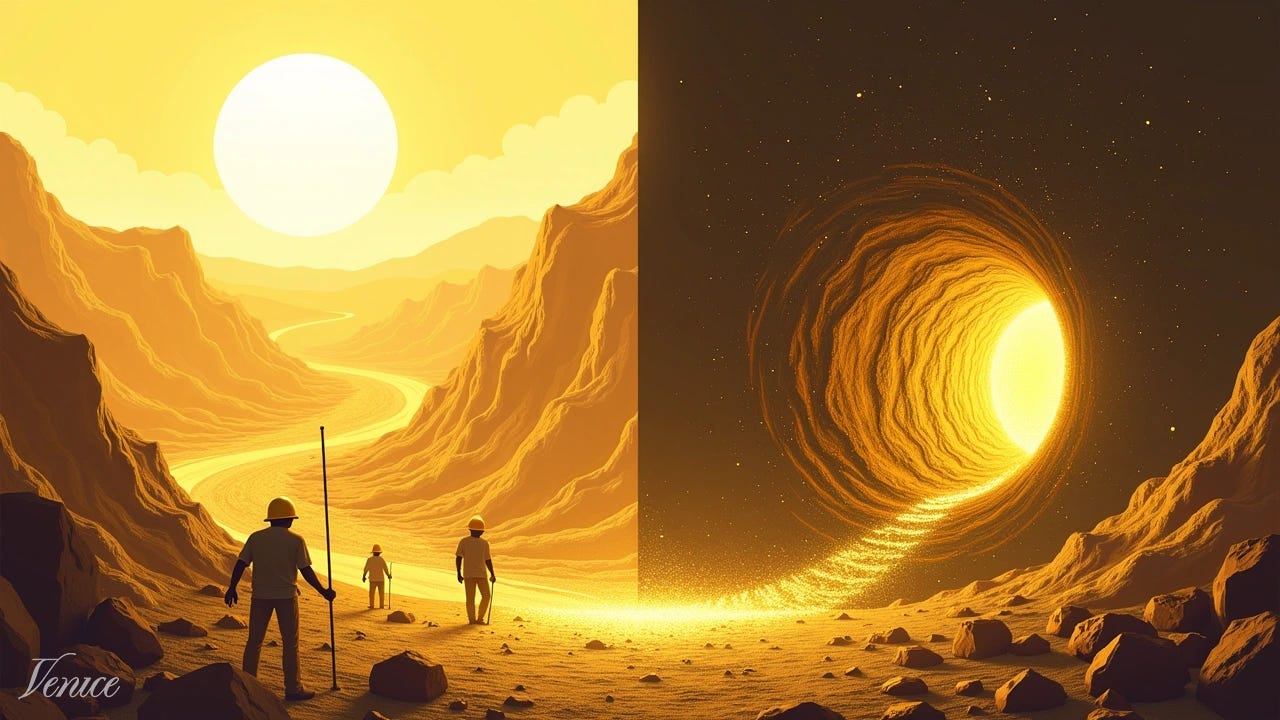Gold From Lead? How CERN’s Breakthrough Could Rewrite Scarcity and Value in 2025
Unpacking CERN’s Lead-to-Gold Breakthrough: Impacts on Gold Scarcity, Value, and Bitcoin in 2025
What if everything you thought you knew about gold’s value flipped overnight? On May 13, 2025, scientists at CERN’s Large Hadron Collider (LHC) turned lead into gold—89,000 atoms per second, to be exact. Sure, it’s a tiny amount, barely 29 picograms over three years, but the symbolism is seismic. For centuries, alchemists chased this dream, and now modern physics has cracked it open. Isaac Newton, who dabbled in alchemy himself, once wrote, “The changing of bodies into light, and light into bodies, is very comfortable to the course of nature” (Newton Project, 2025). Could this breakthrough mess with gold’s scarcity, its price, or even how it stacks up against digital gold like Bitcoin? Let’s break it down with a story, some hard numbers, and a spicy “what if” to chew on.
Picture Sarah, a 30-something jewelry designer in Brooklyn. She’s got a small business selling gold necklaces, sourcing her materials from a local supplier. Last week, she read about CERN’s experiment on X and panicked. Would gold prices crash? Would her business survive if gold became as common as copper? Sarah’s story isn’t real, but her fears echo what many are wondering after this news dropped.
The Science Behind Turning Lead Into Gold: A Modern Alchemy Tale
CERN’s breakthrough isn’t magic—it’s physics. At the LHC, scientists used the ALICE detector to smash lead ions at near-light speeds. Instead of head-on collisions, they focused on “near-miss” events where electromagnetic fields strip three protons from lead atoms, leaving gold behind. From 2015 to 2018, they produced 86 billion gold atoms, or 29 picograms. That’s less than a trillionth of a gram—hardly enough to make a ring, let alone flood the market.
Here’s the catch: each gold atom lasts microseconds before decaying. Plus, the process is wildly expensive. The LHC consumes 200 MW of power, costing millions yearly (CERN Annual Report, 2024). According to a May 13, 2025, article on theconversation.com, producing gold this way costs a trillion times its market price—about $2,500 per ounce in 2025. Compare that to global gold mining, which churns out 3,000 metric tons annually (World Gold Council, 2025). CERN’s 29 picograms is a speck next to 3 billion grams mined each year.
Still, the symbolism matters.
Marie Curie, the pioneer of radioactivity, once said, “Nothing in life is to be feared, it is only to be understood” (Nobel Prize Archives, 1937).
Understanding this process might not change gold’s supply today, but it opens doors to questions about scarcity and value that ripple far beyond the lab.
Gold’s Scarcity Under the Microscope: Will It Hold?
Gold has been a symbol of wealth for 5,000 years because it’s rare, durable, and hard to mine. About 190,000 tons exist above ground, with a market cap of $15 trillion at $2,500 per ounce (World Gold Council, 2025). Annual mining adds 3,000 tons, but the CERN experiment doesn’t come close to denting that. To make one gram of gold, you’d need 3.1 trillion trillion atoms. At 89,000 atoms per second, the LHC would take billions of years to produce a gram. Hardly a threat to scarcity.
But let’s zoom out. Gold’s scarcity isn’t just about numbers—it’s about perception. When X user @Legal_Eagle_52 asked, “Does that mean the value of gold is about to go down the tubes?” they tapped into a real fear. If people think gold can be “made” in a lab, its mystique might fade. Yet the reality is more grounded. The cost and scale of CERN’s process make it a scientific marvel, not a market disruptor. Gold’s role as a safe-haven asset—think of it as a financial lifeboat during crises—remains intact.
Here’s a visual to drive it home:
Elon Musk, who’s no stranger to shaking up industries, once quipped, “The most entertaining outcome is the most likely” (X Post, 2023).
If that’s true, gold’s scarcity might face bigger threats from asteroid mining in the future than from CERN’s lab experiments.
Gold vs. Bitcoin: A Scarcity Showdown in the Digital Age
Now let’s bring Bitcoin into the mix—often called “digital gold” for its capped supply of 21 million coins. As of May 2025, 19.7 million BTC are in circulation, with a market cap of $1.58 trillion at $80,000 per coin (extrapolated from 2023 prices and halving trends). Unlike gold, Bitcoin’s scarcity is coded into its DNA. No one can “make” more Bitcoin, as X user @CryptoMoon66 pointed out: “But they can’t create more Bitcoin. Let that sink in.”
Gold’s scarcity, on the other hand, is geological. While CERN’s experiment doesn’t threaten it now, it raises questions. Bitcoin’s supply is predictable—halvings every four years slow new coin issuance, and by 2140, all 21 million will be mined. Gold’s supply could grow if new deposits are found or if tech like CERN’s ever becomes cost-effective (spoiler: not anytime soon).
Let’s compare their market dynamics:
Gold: $15 trillion market cap, physical asset, deep cultural roots. It’s a hedge against inflation, but it’s less portable for global trade.
Bitcoin: $1.58 trillion market cap, digital, censorship-resistant. It’s easier to transfer but more volatile—its price can swing 20% in a day.
Satoshi Nakamoto, Bitcoin’s mysterious creator, wrote in 2009, “It might make sense just to get some in case it catches on” (Bitcoin Whitepaper, 2009).
If CERN’s breakthrough makes investors question gold’s scarcity, even a little, Bitcoin might gain as a “purer” scarce asset. But gold’s 5,000-year history isn’t going anywhere.
What If Gold Could Be Mass-Produced? A Controversial Thought Experiment
Here’s where things get spicy. What if, in 50 years, scientists crack the code and make gold production at the LHC cost-effective? Imagine a world where gold is as cheap as aluminum. Sarah, our Brooklyn jeweler, might have to pivot her entire business—maybe she’d start crafting with rare woods instead. Countries hoarding gold in their vaults, like the U.S. with 8,133 tons (Federal Reserve, 2025), could see their reserves lose value overnight. The $15 trillion gold market might collapse, shaking global economies.
On the flip side, industries that use gold—like electronics, where it’s prized for conductivity—might boom. Your smartphone could get cheaper if gold prices tank. But what about Bitcoin? If gold loses its safe-haven status, investors might flock to BTC, pushing its price to $500,000. Or maybe they’d ditch both for something new entirely—like a quantum-based currency we can’t even imagine yet.
This “what if” sparks debate. Some, like X user @michael_esq1 , worry about inflation: “Great so now we can literally print gold for money.” Others, like @DavidZsutty, dismiss the breakthrough as “cheating” compared to alchemy’s spiritual roots. The tension lies in whether technological progress could ever truly upend a metal that’s defined wealth for millennia.
Carl Sagan, the famed astronomer, once said, “Somewhere, something incredible is waiting to be known” (Cosmos, 1980). If that something is a world where gold is no longer rare, the ripple effects could redefine value itself.
Reflecting on Value in a Changing World
CERN’s lead-to-gold experiment is a jaw-dropping feat, but it’s not rewriting economics just yet. Gold’s scarcity and value hold steady—for now. Bitcoin, with its unchangeable supply, offers a different kind of security in a digital age, though it lacks gold’s tangible history. The “what if” of mass-produced gold stirs the pot, forcing everyone to rethink what makes something valuable. Is it rarity? History? Or just what we collectively decide to believe in?
Sarah, our fictional jeweler, might sleep easier knowing her business is safe for now. But the bigger question lingers: in a future where science can bend nature’s rules, what will humans treasure next? Maybe the answer lies not in gold or Bitcoin, but in something entirely new—something waiting to be discovered.
Albert Einstein, who knew a thing or two about upending the status quo, once mused, “Imagination is more important than knowledge. For knowledge is limited, whereas imagination embraces the entire world” (Interview, 1929).
As 2025 unfolds, that imagination might just shape the future of value itself.
What do you think the next “gold” will be in 50 years? Drop your thoughts in the comments!
Sources
CERN Annual Report 2024: home.cern/about/reports
World Gold Council, 2025 Gold Statistics: www.gold.org/goldhub/data
The Conversation, “CERN’s Lead-to-Gold Experiment: A Scientific Nuisance?” May 13, 2025: theconversation.com/cerns-lead-to-gold-experiment
Bitcoin Whitepaper, Satoshi Nakamoto, 2009: bitcoin.org/bitcoin.pdf
Federal Reserve Gold Holdings, 2025: www.federalreserve.gov/data
Newton Project, Isaac Newton’s Alchemical Writings, 2025: www.newtonproject.ox.ac.uk








